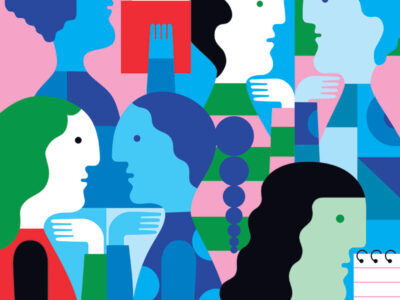
Rethinking a medical career in Guatemala.
By Jason Nagata
The roar of fireworks signals the beginning of the race. Jumping off the creaky wooden dock into Lake Atitlán, I plunge into water brisk enough to make my skin tingle even on a tropical summer day. Volcanoes blanketed by lush green foliage surround the mile-high lake on all sides. Today’s swim marks the end of Guatemala’s weeklong Festival of Santiago, full of music, dance, and laughter. Santiago’s swim competition is unusual for me: The course’s exact distance is unknown and individual times are not recorded. Nonetheless, hundreds of Atitecos gather by the colorful balloon finish line, which hovers over the docks at Santiago Atitlán’s main port. My host family here, the Cabreras, are cheering me on in the crowds. I am humbled by the fact that cousins and aunts have traveled from as far as Xela, a four-hour bus ride, to support me today. As I complete the race, they greet me with a towel and proud hugs, treating me like any other member of the Cabrera family.
I had come to Santiago Atitlán, Guatemala, to research a Health and Societies senior thesis on how the local Tz’utujil Maya associate food with health, under the mentorship of Dr. Kent Bream and Penn’s Guatemala Health Initiative. But over the course of two months in the spring and summer, it was not food but water that first caught my attention.
Every morning, women descend upon the shoreline to wash their lavender embroidered blouses and their husbands’ white and purple striped pants in the shallows. When finished, they balance the loads on their heads with baskets and return to their homes. In nearby coves, children bathe and swim in the ultimate bathtub. Fishermen navigate their small wooden boats standing upright with one oar, searching for a catch. In this central bay, the village’s water pump labors to replenish the townspeople’s drinking supply. The pumped water is slightly chlorinated to kill bacteria. Nevertheless, some Atitecos persist in gathering their drinking water directly from the lake.
To find out why, I traveled by boat to the village of Santa Cruz, where Dr. Craig Sinkinson runs a health clinic. He offered an unexpected answer: the Guatemala-Maya civil war. From 1954 to 1995, Mayan groups were persecuted by Guatemala’s military. In Santiago Atitlán, 10 locals were killed in an infamous massacre in 1990, exacerbating tensions between the Maya and the government. Although the war officially ended in 1995, distrust of the government still lingers in the community. That suspicion extends to the unnatural taste of chlorine: Some Mayans avoid chlorinated water, Dr. Sinkinson explained, because they think the government poisons it.
Soon I was shadowing Santiago’s official water inspector, Alexis Castillo, who tests tap water all around the village once a month. I followed him on one of these days, riding to all seven cantones, or zones, of Santiago. With his encouragement I later gathered water samples directly from the lake, discovering that Santiago’s water pump is located in one of its most polluted portions.

Working with my Penn professors and host family, I initiated a water-quality commission with the mayor, the Ministry of Health, and community members to develop a strategy for cleaning the bay where the water is pumped. The commission came up with ideas for the future, which included filtering or diverting the sewage runoff and creating public laundry areas so Atitecos do not have to wash their clothes directly in the lake.
Around the same time, I met a single mother named Josefa who has lived with her five children in a corrugated metal shack ever since mudslides from Hurricane Stan destroyed their home two years ago. During my first visit, her nine-year-old daughter, Nicolasa, began eating dirt off of the ground. Seeing this threw me off guard and stopped my question in mid-sentence. Josefa burst into tears, explaining that she only earned enough to feed her children two small meals a day. As a result, Nicolasa regularly ate dirt to quell her constant hunger and consequently had sustained diarrhea for the past six years. The persistence of Nicolasa’s diarrhea for so long shocked me, but Josefa’s harsh dilemma again underscored the fact that any solution would have to take more than one individual into account.
Josefa’s predicament was a wake-up call for me. In American medical care, the principle of autonomy reigns supreme. We are often willing to spend as much money as it takes to cure an individual. But that model didn’t seem to apply here.
After a social worker arranged for a doctor’s appointment and medication at a greatly reduced price, Nicolasa’s diarrhea stopped. But clearly medication alone would not solve her larger problem of hunger. To address sustainability, my host grandmother, a nutritionist, and I worked with Josefa every week to plan affordable, nutritious, and culturally acceptable meals. We began by cooking Incaparina, an inexpensive protein drink developed for children with protein deficiencies. We found market vendors who sold cheap fruit, such as five bananas for one Quetzal (about 14 cents). Soups of local herbs, including chipilin and mora, also were reasonably priced, nutritious, and tasty. Perhaps most importantly, we explained to Josefa the importance of boiling water to kill germs.
During my stay in Santiago, headlines in the Prensa Libre newspaper announced that over half of Guatemalan children under five years old are malnourished. Reading about and experiencing the global ubiquity of hunger led me to reassess my own career aspirations. While in Guatemala, I was in the midst of applying to medical schools. Curing and healing patients on an individual level has always been appealing to me. However, my time in Santiago Atitlán made me also appreciate the importance of community-level health.
In America, a narrow focus on the individual patient is almost always the most important consideration in medical decision-making. In Guatemala, however, families and communities are often the most important decision makers. When resources are extremely limited, Atitecos are forced to look at the big picture. Nicolasa did not get diarrhea treatment for so long because its cost might mean starvation for her siblings. For the Cabrera family, supporting the family was a top priority. This explained why aunts, uncles, and cousins traveled long distances to be together nearly every weekend, whether to celebrate someone’s birthday, to care for a sick relative, or to attend an adopted family member’s swimming race. Realizing the importance of family and community-health considerations in Guatemala led me to broaden my career plans. I began to investigate public health programs that focused on community nutrition, which I hope to pursue in conjunction with a medical degree. I know now that communities are not limited to headcounts; they are made up of people whose stories are intertwined, like those of Josefa, Nicolasa, and the Cabrera family. For me, research in Guatemala illuminated a career in community health.
Jason Nagata is a College senior from Monterey Park, California.




